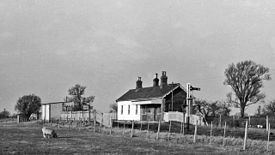Grid reference TQ997264 | Platforms 2 then 1 | |
 | ||
Pre-grouping Lydd Railway CompanySouth Eastern RailwaySouth Eastern and Chatham Railway Post-grouping Southern RailwaySouthern Region of British Railways Similar Greatstone‑on‑Sea Halt railway st, East Minster railway st, Dungeness (SER) railway st, Teston Crossing Halt railw, Longfield Halt railway st | ||
Brookland Halt was a railway station which served the village of Brookland in Kent, England. The station opened in 1881 and closed in 1967.
Contents
History
Brookland was the first station on the Lydd Railway Company's New Romney branch line which opened to traffic on 7 December 1881. The station was ½ mile from Brookland village, one of the larger settlements on Romney Marsh, and an area well known for games and wrestling as well as smuggling. It was located on the north side of the A259 Straight Lane which links the villages of Brenzett and Brookland; a small ground frame shed controlled the level crossing manned by a resident signal-porter who also sold tickets. Brookland was once an impressive station boasting two platforms, with the main station building on the down side and a small wooden waiting shelter on the up side. A passing loop was also provided, but this was removed in 1921. As passenger traffic dwindled and freight became insignificant in the post-war period, the New Romney branch fell into decline and subsequently figured in the Beeching Report along with the Ashford to Hastings line. In 1966 the Minister of Transport Barbara Castle announced her intention of closing the Appledore to New Romney Branch and passenger services ceased on 6 March 1967, with the section between Romney Junction and New Romney closing entirely.
Present day
The station building remains as a private residence and the down platform remains extant if overgrown; the up platform has been partially covered in soil and is heavily overgrown. The line through the station remains open for freight traffic and is subject to a 20 mph speed restriction. The level crossings are unmanned and have to be operated by the train crew. The line sees regular nuclear waste traffic from Dungeness nuclear power station.
